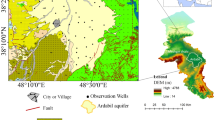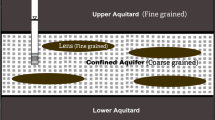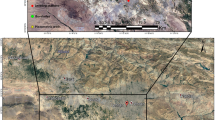Abstract
Iran as a semi-arid and arid country has a serious water challenge in the recent decades. While water demand is increasing, as a consequence, land subsidence due to excessive water extraction is happening in major basins of the country. Recently the land subsidence has been proposed as an environmental problem in the country and thus important projects on this matter have been conducted. For example several basins in the country have been studied using SAR data and their result had a great deal on water management section. This paper studies the large-scale immature land subsidence in the Tabriz basin (NW Iran) using the permanent scatterer synthetic aperture radar interferometry technique with the small baseline InSAR approach and watershed analysis. InSAR time series analysis of 17 Envisat advanced SAR images between 2003 and 2010 reveals three oval-shaped regions of subsidence. The recognized water wells in the study area are categorized into two groups (sub-basin 1 and 2) based on watershed analysis in the TB and are compared with InSAR results. InSAR time series from Kriging interpolation method are also compared with GPS time series of permanent TABZ station which suggests that the land subsidence only is growing in the basin far away from the Tabriz city.







Similar content being viewed by others
References
Akbari V, Motagh M (2011) Improved ground subsidence monitoring using small baseline SAR interferograms and a weighted least squares inversion algorithm. Geosci Remote Sens Let IEEE 9:437–441
Akbarimehr M, Motagh M, Haghshenas-Haghighi M (2013) Slope stability assessment of the Sarcheshmeh landslide, Northeast Iran, investigated using InSAR and GPS observations. Remote Sens 5(8):3681–3700
Alipour S, Motagh M, Sharifi M, Walter T.R (2008) InSAR Time Series investigation of Land Subsidence due to Groundwater Overexploitation in Tehran, Iran. IEEE second workshop
Anderssohn J, Wetzel H-U, Walter TR, Motagh M, Djamour Y, Kaufmann H (2008) Land subsidence pattern controlled by old alpine basement faults in the Kashmar Valley, northeast Iran: results from InSAR and levelling. Geophys J Int 174:287–294
Bell JW, Amelung F, Ferretti A, Bianchi M, Novali F (2008) Permanent scatterer InSAR reveals seasonal and long-term aquifer-system response to groundwater pumping and artificial recharge. Water Resour Res 44:W02407. doi:10.1029/2007WR006152
Dehghani M, ValadanZoej MJ, Entezam I, Mansourian A, Saatchi S (2009) InSAR monitoring of progressive land subsidence in Neyshabour, Northeast Iran. Geophys J Int 178:47–56
Djamour Y, Vernant P, Nankali HR, Tavakoli F (2011) NW Iran-eastern Turkey present-day kinematics: results from the Iranian permanent GPS network. Earth Planet Sci Lett 307:27–34
Ferretti A, Prati C, Rocca F (2001) Permanent scatters in SAR interferometry. IEEE Trans Geosci Remote Sens 39(1):8–20
Food and Agriculture Organization of the United Nations (FAO) (2009) Groundwater management in Iran, report
Freemantle T, Muller J.P (2010) Monitoring ground surface displacement in the Three Gorges area: an investigation into DEM validation and the application of InSAR, ESA DRAGON2#5343
Galloway DL, Hudnut KW, Ingebritsen SE, Phillips SP, Peltzer G, Rogez F, Rosen PA (1998) Detection of aquifer system compaction and land subsidence using interferometric synthetic aperture radar, Antelope Valley, Mojave Desert, California. Water Resour Res 34(10):2573–2585
Haddadan M, Zohrab E (1994) Hydrogeology map of Tabriz. Geol Surv Iran 1:50000
Hanssen RF (2001) Radar interferometry: data interpretation and error analysis. Kluwer Academic, Dordrecht
Hoffmann J, Zebker HA (2001) Seasonal subsidence and rebound in Las Vegas Valley, Nevada, observed by synthetic aperture radar interferometry. Water Resour Res 37(6):1551–1566
Hooper A, Spaans K, Bekaert D, Cuenca MC, Arıkan M, Oyen A (2010) StaMPS/MTI Manual. Delft University of Technology, Delft
Hu J, Li ZW, Ding XL, Zh JJ, Zhang L, Sun Q (2014) Resolving three-dimensional surface displacements from InSAR measurements: a review. Earth Sci Rev 133:1–17
Kampes B, Usai S (1999) Doris: the delft object-oriented radar interferometric software. In: Proceedings 2nd international symposium operationalization of remote sensing, http://citeseerx.ist.psu.edu/viewdoc/summary?doi=10.1.1.46.1689
Karimzadeh S, Cakir Z, Osmanoğlu B, Schmalzle G, Miyajima M, Amiraslanzadeh R (2013) Interseismic strain accumulation across the North Tabriz fault (NWIran) deduced from InSAR timeseries. J Geodyn 66:53–58
Kim SW, Wdowinski S, Dixon TH, Amelung F, Kim JW, Won JS (2010) Measurements and predictions of subsidence induced by soil consolidation using persistent scatterer InSAR and a hyperbolic model. Geophys Res Lett 37:L05304
Lu Z, Danskin WR (2001) InSAR analysis of natural recharge to define structure of a ground-water basin, San Bernardino, California. Geophys Res Lett 28(13):2661–2664
Lubis AM, Sato T, Tomiyama N, Isezaki N, Yamanokuchi T (2011) Ground subsidence in Semarang-Indonesia investigated by ALOS–PALSAR satellite SAR interferometry. J Asian Earth Sci 40:1079–1088
Madani K (2014) Water management in Iran: what is causing the looming crisis? J Environ Stud Sci 4:315–328
Moghaddam AA, Najib MA (2006) Hydrogeologic characteristics of the alluvial tuff aquifer of northern Sahand Mountain slopes, Tabriz. Iran Hydrogeol J 14:1319–1329
Moghtased-Azar K, Mirzaei A, Nankali HR, Tavakoli F (2012) Investigation of correlation of the variations in land subsidence (detected by continuous GPS measurements) and methodological data in the surrounding areas of Lake Urmia. Nonlinear Process Geophys 19:675–683
Motagh M, Djamour Y, Walter TR, Wetzel H-U, Zschau J, Arabi S (2007) Land subsidence in Mashhad Valley, Northeast Iran: results from InSAR, levelling and GPS. Geophys J Int 168(2):518–526. doi:10.1111/j.1365-246X.2006.03246.x
Motagh M, Walter T, Sharifi MA, Fielding E, Schenk A, Anderssohn J, Zschau J (2008) Land subsidence in Iran caused by widespread water reservoir overexploitation. Geophys Res Lett 35:L1640
Nwankwor GI, Egboka BCE (1992) Leakage properties of the multi-aquifer system underlying the greater Onitsha water scheme borehole field, Anambra State, Nigeria. Hydrol Sci J 37(6):557–566
Osmanoğlu B, Dixon TH, Wdowinski S, Canob EC, Jianga Y (2011) Mexico City subsidence observed with persistent scatterer InSAR. Int J Appl Earth Obs Geoinf 13:1–12. doi:10.1016/j.jag.2010.05.009
Razzaghmanesh M, Salemi T, Seraj M (2006) Ground water quality and quantity of Tabriz plain. In: National conference on irrigation and drainage network management (In Persian)
Rigo A, Béjar-Pizarro M, Martínez-Díaz J (2013) Monitoring of Guadalentín valley (southern Spain) through a fast SAR Interferometry method. J Appl Geophys 91:39–48
Riley FS (1969) Analysis of borehole extensometer data from Central California. Int Assoc Sci Hydrol Publ 89:423–431
Rizza M, Vernant P, Ritz JF, Peyret M, Nankali H, Nazari H, Djamour Y, Salamati R, Tavakoli F, Chery J, Mahan SA, Masson F (2013) Morphotectonic and geodetic evidence for a constant slip-rate over the last 45 kyr along the Tabriz fault (Iran). Geophys J Int 193:1083–1094
Sedighi M, Nankali HR, Arabi S, Tavakoli F (2010) Subsidence detection in Salmas area using InSAR and geodetic techniques. Geospatial Eng J 1(4):25–33
Sousa J, Hooper A, Hanssen R, Luisa B, Antonio R (2011) Persistent Scatterer InSAR: a comparison of methodologies based on a model of temporal deformation versus spatial correlation selection criteria. Remote Sens Environ 115:2652–2663
Tomás R, Herrera G, Delgado J, Lopez-Sanchez JM, Mallorquí JJ, Mulas J (2010) A ground subsidence study based on DInSAR data: calibration of soil parameters and subsidence prediction in Murcia City (Spain). Eng Geol 111:19–30
Wessel P, Smith WHF (1995) New version of the generic mapping tools released. EOS Trans Am Geophys Union 76(33):329
Acknowledgments
European Space Agency (ESA) has provided Envisat ASAR data for Tabriz region through the Category-1 research proposal # 8094. Most figures were generated using public license Generic Mapping Tools (GMT) software (Wessel and Smith 1995). Two anonymous reviewers are thanked for invaluable comments on earlier draft of the manuscript and suggesting substantial improvements.
Author information
Authors and Affiliations
Corresponding author
Rights and permissions
About this article
Cite this article
Karimzadeh, S. Characterization of land subsidence in Tabriz basin (NW Iran) using InSAR and watershed analyses. Acta Geod Geophys 51, 181–195 (2016). https://doi.org/10.1007/s40328-015-0118-4
Received:
Accepted:
Published:
Issue Date:
DOI: https://doi.org/10.1007/s40328-015-0118-4




